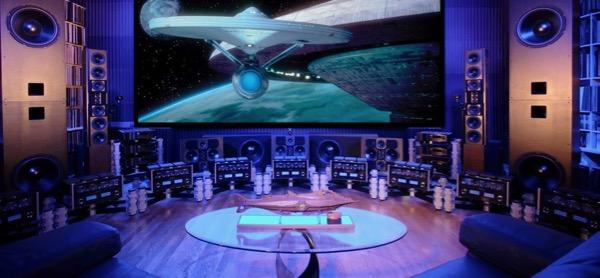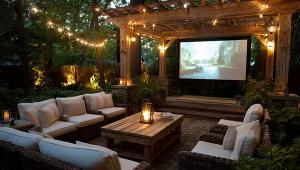What Defines a Home Theater?

The subject being discussed was what sort of home improvements homeowners were investing in these days. In the current environment it may seem odd that some folks are putting in swimming pools, adding bedrooms, and remodeling here and there. But if it keeps contractors in business and their workers employed I’m happy for them. One question asked of the commentator was if these upgrades included an uptick in home theater installations. Given the current (non) status of commercial movie theaters, this seemed logical. The answer given, however, was a definite no. With the ability to now watch and listen on portable devices such as smartphones and tablets, the responder claimed that some current home theater owners are even converting their entertainment spaces to home offices or other more pressing needs. Yuck.
With all due respect to those happy to cuddle up with their iPhone and a pair of earbuds to watch the latest Avengers movie, or something newer that hasn’t yet shown up in their local, still shuttered movie theaters, I beg to disagree. But that raises the question of what, exactly, constitutes a “home theater.”
For some, it’s the sort of thing the commentator here was talking about: a dedicated room set aside strictly for movie watching. It’s typically either highly decorated in an AV Interiors style ranging from an Egyptian crypt to the command deck of the USS Enterprise, or a nondescript black hole for wringing the most from a separate projector and screen. These specialized installations have spawned an entire home theater industry since the '90s. They can range from reasonably affordable but hardly cheap (often with a lot of DIY as sweat equity), to contracted work at prices that would make a Ferrari dealer blush.
There’s something to be said for having a dedicated space for watching movies with family and friends, one that can also serve as a comfortable retreat for just listening to music when the full A/V experience isn’t the on the schedule. For most of us, however, a home theater is part of a larger living space, often in a living room, den, or family room that can also be used for purposes other than just watching movies. Some call it a media room. It’s also often a larger and more open-concept space than that dedicated spare room, a plus for those Super Bowl parties but also a negative for your budget (the bigger the space, the more grunt the system must have to fill it with the big sound that home theater fans crave).
For many folks their home theater is simply a TV and a decent soundbar. While many of us might turn up our noses at this concept, don’t judge. Many of the TV + soundbar brigade will one day expand out into something closer to a true home theater. It isn’t a big stretch of the imagination (though it can be a stretch of the wallet) to see them later acquiring an AV receiver and a full set of surround speakers, including a subwoofer or two, and passing that soundbar off to cousin Sam. Having a living space that also doubles as a home theater isn’t the sort of home upgrade that registers with a real estate professional. It is one, however, that often requires the approval of the decorating committee the biggest obstacle of all. “Suggestions” to avoid if at all possible include mounting all of the speakers in the ceiling (apart from Atmos speakers that thrive there), and speakers mounted in the walls (in-wall speaker vendors are reaching for their torches and pitchforks even as I write). In-wall speakers can work, but you only have one shot at getting their location right, a 50-50 chance at best. If you get it wrong you’re stuck with it, unless you like patching holes in the walls. In-wall subs are an even worse bet; subwoofer positioning is critical for achieving the best result and no one can tell you the best locations in your room without first trying them out. You can’t just "fix it in the mix."
There’s also the ever-popular, ever regrettable, TV over the fireplace. Decorators hate TVs, and putting one above the fireplace is often considered the only workable compromise. But unless you watch from a recliner you’ll get a nasty crick in your neck from that Lord of the Rings marathon. And be sure that all the chairs are positioned to look straight at the screen, or can be easily moved into that position and later returned to where they were for more routine activities. A couple of accent chairs or even recliners are easier to move around than a heavy sofa. We’ve all seen ads showing smiling folks watching a TV positioned at 90-degrees to them. Time for a neck brace.
But I digress a lot. I could add dozens of similar observations, but not today. A home theater is what you make it. I’d never call it an iPad and a set of headphones, but that real estate commentator obviously knew little about what a home theater could actually be. He was thinking, as realtors often do, of dedicated spaces rather than a more generalized concept for a better home entertainment experience. And with many of us spending more time at home these days, either by choice or not, that’s even more important now than in more normal times.






























































